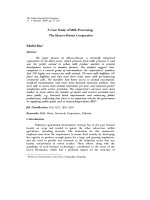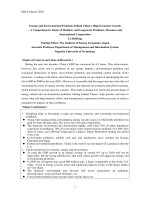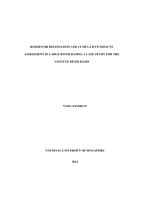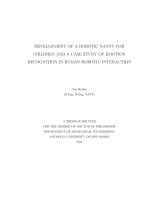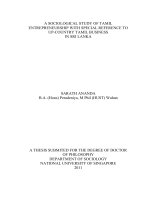tiểu luận A delphi study of internet banking
Bạn đang xem bản rút gọn của tài liệu. Xem và tải ngay bản đầy đủ của tài liệu tại đây (4.61 MB, 36 trang )
A Delphi Study of
Internet Banking
Team 9 – Subject No.1
Content
PHẦN I:
GIỚI THIỆU
PHẦN II: CƠ SỞ LÝ THUYẾT
PHẦN III: PHƯƠNG PHÁP NGHIÊN CỨU
PHẦN IV: KẾT QUẢ NGHIÊN CỨU
Giới thiệu
1.
Tên đề tài:
A Delphi study of Internet banking
Nghiên cứu Delphi đối với Internet banking.
Giới thiệu
2. Phương pháp Delphi: Đây là phương pháp dự báo bằng cách trưng cầu ý kiến.
Đặc điểm:
- Đánh giá tập thể vắng mặt
- Có tính khuyết danh
- Sử dụng tích cực các mối quan hệ ngược để điều chỉnh các câu trả lời
Giới thiệu
3. Lỗ hổng nghiên cứu
“A futures perspective will be taken since there is a vast amount of contradictory views emerging
regarding the future of Internet banking and the majority of studies to date have taken a more
historical view. Further to this, the scant historical data of Internet banking does not provide a
secure base from which to make predictions.”
(Page 273, Column 2, Paragraph 4)
Delphi thuộc loại nghiên cứu dự báo
Giới thiệu
4. Mục tiêu nghiên cứu – Câu hỏi nghiên cứu
4.1. Mục tiêu nghiên cứu
“The current research empirically investigated the future of Internet banking” (P274-C1-P2)
Nghiên cứu này nhằm mục đích dự đoán được tương lai của Internet banking
Giới thiệu
4.2. Câu hỏi nghiên cứu
Importance of Internet banking - Tầm quan trọng của IB ra sao?
Industry leaders - Chiến lược mũi nhọn của ngành là gì?
Channel usage in the future - Kênh sử dụng trong tương lai là gì?
Level of functionality - Vị trí chức năng của IB trong hiện tại và tương lai ra sao?
Predicted future level of industry adoption - Dự đoán mức độ phát triển trong tương lai?
Advantages to incumbents and new entrants - Những lợi ích dành cho ngân hàng cũ và mới
triển khai có gì khác nhau không?
Giới thiệu
5. Phạm vi nghiên cứu:
- Phạm vi địa lý:
“The geogreaphical base for study was the USA and Europe.”
Phạm vi địa lý cho nghiên cứu là Hoa Kỳ và các nước châu Âu.
- Thời gian thực hiện là 12/2000 – 12/2001
- Đối tượng tham gia:
“These included panellists involved in retail banking, non-financial service entrants, technology and
software supplierrs and consultants and academics engaged in researching the banking industry.”
Cơ sở lý thuyết
1. Khái niệm Internet banking
“Internet banking presents the industry with an electronic and remote distribution chanel.”
(P272-C1-P3)
Internet banking đề ra một phương thức hoạt động kinh doanh mới với kênh phân phối điện
tử từ xa.
Cơ sở lý thuyết
“Internet banking is predicted to transform and revolution this traditional industry (Mols, 1999;
Daniel, 1999; Carrington et al.,1997). Banking activities are easily digitised and automated and,
thus, from an operational perspective, lend themselves to the Internet.” (P272-C1-P3)
IB được dự đoán là sẽ làm một cuộc cách mạng đối với ngành ngân hàng truyền thống. Hoạt
động giao dịch sẽ được dễ dàng và tự động số hóa và thông qua các mô hình vận hành sẽ được
truyền tải lên Internet.
Cơ sở lý thuyết
2. Tổng kết lý thuyết về phương pháp Delphi:
“Delphi is a technique used in researching the future and forecasting.” (P274-C2-P2)
Delphi là một phương pháp kỹ thuật được sử dụng trong nghiên cứu xu hướng và dự báo
tương lai.
Quy trình thu thập dữ liệu:
“This methodology involves soliciting the opinions of experts over a series of rounds.” (P274-C2P4)
Phương pháp này bao gồm việc lấy ý kiến của các chuyên gia thông qua một số vòng trả lời.
Cơ sở lý thuyết
“The first round of a traditional Delphi study should discuss the general focus of the study.”
(P274-C2-P4)
Vòng đầu tiên của một nghiên cứu Delphi là thảo luận vấn đề trọng tâm của nghiên cứu.
“The second round gives feedback from the first round and asks for any revision of opinion in
light of the findings and justification by those who provide deviating views”. (P274-C2-P4)
Vòng thứ hai cho các đối tượng biết ý kiến phản hồi từ vòng đầu tiên và đề nghị đưa ra sự điều
chỉnh trong câu trả lời.
Cơ sở lý thuyết
“The final round normally involves distribution of the justifications and the opportunity for panel
members to agree or disagree with the justifications provided”. (P274-C2-P4)
Vòng cuối thường đưa ra các luận cứ cho các thành viên nêu ý kiến đồng ý hoặc không đồng ý
với luận cứ đó.
Cơ sở lý thuyết
3. Diễn giải khái niệm nghiên cứu
Importance of Internet banking - Tầm quan trọng của IB
“The panellists were asked: ``How important do you feel online banking is within the overall
future of retail banking?” (P276-C2-P2)
Khái niệm đơn hướng – thang đo khoảng Likert.
Cơ sở lý thuyết
Diễn giải khái niệm nghiên cứu
Channel usage in the future - Kênh giao dịch sử dụng trong tương lai
“Panellists were asked to estimate the usage by retail bank customers worldwide of various
banking channels.” (P276-C2-P3)
Khái niệm đơn hướng – thang đo tỷ lệ.
Cơ sở lý thuyết
Diễn giải khái niệm nghiên cứu
Level of functionality - Phân cấp chức năng
“Panellists were asked to estimate the current level (2001) and the predicted level (2011) of
services to be made available through Internet banking.”
(P276-C2-P5)
Khái niệm đơn hướng – thang đo định danh.
Cơ sở lý thuyết
Diễn giải khái niệm nghiên cứu
Predicted future level of industry adoption - Dự đoán mức độ phát triển trong tương lai
“The expert panel was asked to complete the following statement: ``By 2011, I estimate that X per
cent of retail banks will have adopted online banking''” (P276-C2-P7)
Khái niệm đơn hướng – thang đo tỷ lệ.
Cơ sở lý thuyết
Diễn giải khái niệm nghiên cứu
Advantages to incumbents and new entrants - Những lợi ích dành cho ngân hàng cũ và mới
triển khai.
“Panellists were asked to indicate how accurate the following statement is: ``Online banking
offers the same advantages to established retail banks and new entrants to the banking market''”
(P277-C1-P2)
Khái niệm đơn hướng – thang đo Likert.
Cơ sở lý thuyết
Diễn giải khái niệm nghiên cứu
Industry leaders - Chiến lược mũi nhọn của ngành.
“Panellists were asked to identify the distribution channel structure of industry leaders within
retail banking both now and in the future.” (P277-C2-P2)
Khái niệm đơn hướng – thang đo định danh.
Phương pháp nghiên cứu
1. Mẫu: n = 71 Chọn mẫu theo phương pháp định mức (phi xác suất)
“Initially, 71 individuals agreed to participate, with a breakdown of panellists illustrated in Table
I.”
(P275-C2-P2)
Phương pháp nghiên cứu
2. Cách thu thập dữ liệu
Phỏng vấn trực tiếp tại vòng phỏng vấn thăm dò.
“Personal interviews were used to afford greater exploration and time to probe and delve into the
major emerging issues.” (P274-C1-P3)
Gửi câu hỏi điện tử tại vòng 1 trong phương pháp Delphi.
“Round one of the study commenced in September 2001, with a questionnaire being electronically
posted to panellists.” (P275-C2-P3)
Phương pháp nghiên cứu
Cách thu thập dữ liệu
Gửi câu hỏi thông qua email ở vòng 2 trong phương pháp Delphi.
“The second round was limited to responding via electronic mail owing to difficulties experienced
in the first round with the on-line responses. “
(P275-C2-P4)
Phương pháp nghiên cứu
3. Công cụ thu thập dữ liệu
Bảng 16 câu hỏi được hình thành từ vòng phỏng vấn thăm dò.
“The questionnaire contained a total of 16 questions, with a mixture of Likert scale, multiple
choice, sentence completion and open-ended questions” (P275-C2-P3)
Phương pháp nghiên cứu
4. Xử lý dữ liệu
Phương pháp xử lý dữ liệu: SPSS
“The results from the Delphi study were analysed using the Statistical Processing for Social
Sciences (SPSS) package.” (P276-C1-P3)
Thang đo: Likert, tỷ lệ, định danh như đã phân tích ở trên.
Kết quả nghiên cứu
1. Kết quả đạt được
Importance of Internet banking - Tầm quan trọng của IB
“91 per cent identified that Internet banking was very important or of very great importance to
retail banking” (P276-C2-P2)
91% nhận thấy IB là hết sức quan trọng đối với dao dịch nhỏ lẻ. Quan điểm đó đã thống nhất
khi 2/3 số người tham gia không thay đổi câu trả lời của họ từ vòng 1 tới vòng 2.


